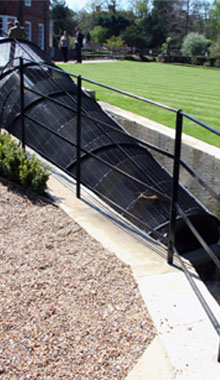Overview
There is considerable potential for micro hydro electricity in the UK. Micro hydro refers to hydro power systems with a power rating of 100kW or less.
 A proper install has no negative effects on the local water source, simply diverting a portion of available water from the stream to power the system before returning it unaltered. An initial analysis of your site may indicate if you should investigate a local water source's potential as a source of electricity.
A proper install has no negative effects on the local water source, simply diverting a portion of available water from the stream to power the system before returning it unaltered. An initial analysis of your site may indicate if you should investigate a local water source's potential as a source of electricity.
The power available from the river depends on the flow rate of the water and the fall (head). The theoretical power available is the product of head and flow. Systems with a larger head are normally more efficient as the turbines can run at a higher speed. For this reason the most suitable technology to choose will depend on the volume of water available and the head. It should be borne in mind that not all of the water in the stream can be diverted for energy production as water must remain in the stream for environmental reasons and the Environment Agency will regulate what you are permitted to do.
The Mill House project our latest Micro-Hydro installation Visit the Frensham Mill website for detailed information.
How it works
Micro Hydro is a condensed version of traditional Hydro Electric Generation.
Electricity is produced by channelling a body of water (such as a damned stream, a flowing river, or a water body with a sufficient fall in height) into a turbine. This turbine then produces electricity and ejects the water back into the original source further downstream.
A correctly specified and designed system should not affect the local ecosystem or the water source.
Several different types of water turbines can be used in micro hydro installations, depending on the head of water, the volume of flow, and such factors as availability of local maintenance and transport of equipment to the site.
Considerations
The key requirement is of course a stream of flowing water with a sufficient head to produce a worthwhile amount of power. Bear in mind that not all of the potential energy can be used.
- You will be able to extract probably less than 50% of the energy in the flow because you cannot reduce the flow to zero in the outlet of the system.
- The Environment Agency are likely to apply some limits to how much flow you can divert through the system to preserve the river environment.
- The system will have some mechanical losses.
Taking all these factors into account if you have a river or lake that has the potential to generate 3-4kW of electricity or more it is likely to be worthwhile exploring the options.
Gallery
Video







